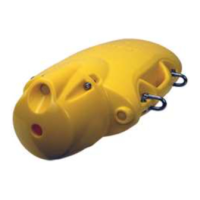Troubleshooting and Maintenance
974-24007001/5.0 75
5.3.1 Wheelhouse Electronics
Once installed these units require little maintenance other than removing dust. A damp,
lint-free cloth should be used for this purpose.
5.3.2 Trawl Unit
The Trawl Unit is subjected to the harshest conditions and therefore proper handling and
maintenance is crucial to ensure trouble free operation.
5.3.2.1 Handling Tips
Though the trawl unit electronics are ruggedized for the fishing environment
mishandling or repeated impacts may result in damage to, or failure of, the electronic
components. Care should be taken at all times to avoid dropping or impacting the
trawl unit or the individual components.
Avoid scratching the surface of the sonar head housings. The anodized surfaces (black
coating) are there to protect the electronic housings from corrosion and any damage to
these surfaces will increase the likelihood of corrosion.
Ensure correct installation of the sonar head into the trawl housing to avoid improper
operation. A locking block is located at the end cap to secure the sonar head into the
lower part of the housing.
Protect connector mating surfaces from corrosion and damage. At the first sign of
damage, connectors should be replaced!
Pigtails must be properly attached to the trawl cable and the connector mating surface
must be protected from moisture and dirt at all times. Failure to do this may result in
water damage to the cable causing improper operation of the sonar system.
5.3.2.2 Maintenance Schedule
For optimum performance and trouble free operation, follow the maintenance schedule
below.
Beginning of Fishing Season
Service all connectors
Every Two Weeks of Continuous Use
The trawl unit package should be opened and the components cleaned with fresh water.
The trawl sonar head should be inspected for corrosion or damage. Service all connectors.
The FS processor should be checked and cleaned if required.

